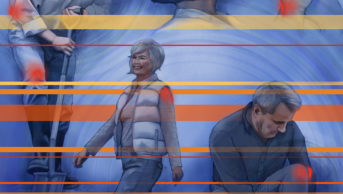
Shutterstock.com
Paracetamol, glucosamine and strong opioids should not be offered to people with osteoarthritis, according to draft guidance published by the National Institute for Health and Care Excellence (NICE).
If pharmacological treatments are needed, these should be given alongside non-pharmacological treatments and to support therapeutic exercise, the guidance states.
Published on 29 April 2022, the draft guideline covers the diagnosis, assessment and non-surgical management of osteoarthritis, with the aim of improving management of osteoarthritis and the quality of life for people with the condition.
The guideline recommends that clinicians offer “tailored therapeutic exercise” to all people with osteoarthritis, such as local muscle strengthening and general aerobic fitness. It also highlights that people with osteoarthritis who have excess weight or obesity should be supported to choose a weight loss goal and be told that any amount of weight loss is likely to be beneficial.
If pharmacological treatments are needed to manage osteoarthritis, the guideline advises offering a topical non-steroidal anti-inflammatory drug (NSAID), and states that, if these are ineffective or unsuitable, an oral NSAID should be offered, provided potential toxicity and risk factors are taken into account.
However, it states that paracetamol, glucosamine and strong opioids should not be offered, and that weak opioids should only be offered for short-term pain relief or if all other pharmacological treatments are contraindicated, not tolerated or ineffective.
Paul Chrisp, director of the Centre for Guidelines at NICE, said: “Osteoarthritis can cause people discomfort and prevent them from undertaking some of their normal daily activities.
“However, there is evidence which shows muscle strengthening and aerobic exercise can have an impact on not just managing the condition, but also providing people with an improved quality of life.
“Beginning that journey can be uncomfortable for some people at first, and they should be supported and provided with enough information to help them to manage their condition over a long period of time.”
While topical and sometimes oral NSAIDs remained an important treatment option for osteoarthritis, Chrisp added that the guideline committee had taken the decision to not recommend some painkillers, such as paracetamol and some opioids.
“This is because new evidence has shown there was little or no benefit to people’s quality of life, pain or psychological distress and, particularly in the case of strong opioids, there was evidence that they can cause harm in the longer term, including possible addiction,” he said.
Tracey Loftis, head of policy and public affairs at Versus Arthritis — a UK charity dedicated to supporting people with arthritis — said that she had seen “first hand” the benefits that people with osteoarthritis can get in being able to access appropriate physical activity, especially in a group setting.
“Something like exercise can improve a person’s mobility, help manage their pain and reduce feelings of isolation,” she said.
“But our own research into the support given to people with osteoarthritis showed that far too many do not have their conditions regularly reviewed by healthcare professionals, and even fewer had the opportunity to access physical activity support.
“The lack of alternatives means that, in many cases, people are stuck on painkillers that are not helping them to live a life free from pain.”
The draft guideline is open for public consultation until 15 June 2022.


